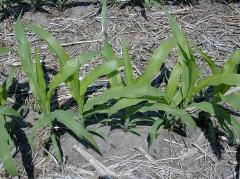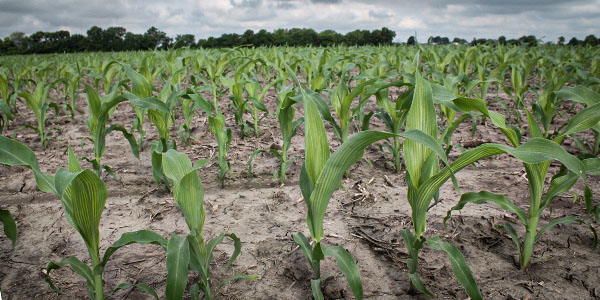AGRONOMICSUPPORT
YOU CAN TAKETO THE FIELD
Importance of Sulfur in Corn Production
You likely already have a plan made for managing nitrogen, phosphorus and potassium – the three primary macronutrients – in your field. But what about the secondary macronutrients: calcium, magnesium and sulfur? While they may not be talked about as much as N, P and K, they’re still critical to crop development. Sulfur is especially important, as it plays a role in protein synthesis, photosynthesis, chlorophyll formation and nitrogen fixation.
 Not having an adequate amount of sulfur can result in reduced plant growth, delayed maturity and overall yield reduction. Lack of sulfur in the soil is easy to see when planting conditions are cool and moist early in the season – conditions that the northern Corn Belt is familiar with. To identify if your field is deficient in sulfur, the first option is to soil sample post-harvest or prior to planting. After crops have been planted and the plants get bigger, another option is to tissue sample. A third option is to check fields during the early vegetation stages and look for yellow striping in the youngest leaves. Sulfur is an immobile nutrient in the plant, which makes it easier to diagnose, even when other nutrient deficiencies can look like sulfur deficiency.
Not having an adequate amount of sulfur can result in reduced plant growth, delayed maturity and overall yield reduction. Lack of sulfur in the soil is easy to see when planting conditions are cool and moist early in the season – conditions that the northern Corn Belt is familiar with. To identify if your field is deficient in sulfur, the first option is to soil sample post-harvest or prior to planting. After crops have been planted and the plants get bigger, another option is to tissue sample. A third option is to check fields during the early vegetation stages and look for yellow striping in the youngest leaves. Sulfur is an immobile nutrient in the plant, which makes it easier to diagnose, even when other nutrient deficiencies can look like sulfur deficiency.
If your field is lacking sulfur, it’s not too late to take action. June is an acceptable time of year to side dress sulfur, whether that’s by injection, foliar or dribbling by the row. Regardless of application method, you will need approximately 0.1 lb to 0.12 lb of sulfur per bushel of corn. For example, if your goal is to have 230 bushel corn at the end of the season, a suitable sulfur application would be 27.6 lb.
If you have questions or need help identifying a possible sulfur deficiency in your field, contact your local LG Seeds Technical Team Agronomist or STAR Partner dealer.
Download a copy of this technical bulletin here: Importance of Sulfur in Corn Production.






Technical Team Agronomist